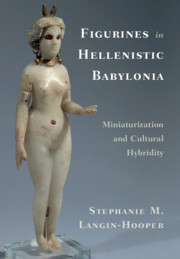Refine search
Actions for selected content:
5894 results in Classical art and architecture

Figurines in Hellenistic Babylonia
- Miniaturization and Cultural Hybridity
-
- Published online:
- 19 December 2019
- Print publication:
- 12 March 2020
General Index
-
- Book:
- The Pasts of Roman Anatolia
- Published online:
- 04 October 2019
- Print publication:
- 17 October 2019, pp 244-252
-
- Chapter
- Export citation
Figures
-
- Book:
- The Pasts of Roman Anatolia
- Published online:
- 04 October 2019
- Print publication:
- 17 October 2019, pp ix-xi
-
- Chapter
- Export citation
Three - Traces
-
- Book:
- The Pasts of Roman Anatolia
- Published online:
- 04 October 2019
- Print publication:
- 17 October 2019, pp 61-103
-
- Chapter
- Export citation
Bibliography
-
- Book:
- The Pasts of Roman Anatolia
- Published online:
- 04 October 2019
- Print publication:
- 17 October 2019, pp 217-240
-
- Chapter
- Export citation
Two - Interpreters
-
- Book:
- The Pasts of Roman Anatolia
- Published online:
- 04 October 2019
- Print publication:
- 17 October 2019, pp 18-60
-
- Chapter
- Export citation
Dedication
-
- Book:
- The Pasts of Roman Anatolia
- Published online:
- 04 October 2019
- Print publication:
- 17 October 2019, pp v-vi
-
- Chapter
- Export citation
Acknowledgments
-
- Book:
- The Pasts of Roman Anatolia
- Published online:
- 04 October 2019
- Print publication:
- 17 October 2019, pp xvii-xviii
-
- Chapter
- Export citation
Six - The Past in Things: Ancient Archaeophilia and Modern Archaeology
-
- Book:
- The Pasts of Roman Anatolia
- Published online:
- 04 October 2019
- Print publication:
- 17 October 2019, pp 180-186
-
- Chapter
- Export citation
Maps
-
- Book:
- The Pasts of Roman Anatolia
- Published online:
- 04 October 2019
- Print publication:
- 17 October 2019, pp xii-xiii
-
- Chapter
- Export citation
Frontispiece
-
- Book:
- The Pasts of Roman Anatolia
- Published online:
- 04 October 2019
- Print publication:
- 17 October 2019, pp xiv-xiv
-
- Chapter
- Export citation
One - Introduction
-
- Book:
- The Pasts of Roman Anatolia
- Published online:
- 04 October 2019
- Print publication:
- 17 October 2019, pp 1-17
-
- Chapter
- Export citation
Copyright page
-
- Book:
- The Pasts of Roman Anatolia
- Published online:
- 04 October 2019
- Print publication:
- 17 October 2019, pp iv-iv
-
- Chapter
- Export citation
Note on Cover Illustration
-
- Book:
- The Pasts of Roman Anatolia
- Published online:
- 04 October 2019
- Print publication:
- 17 October 2019, pp xv-xvi
-
- Chapter
- Export citation
Maps
-
- Book:
- The Pasts of Roman Anatolia
- Published online:
- 04 October 2019
- Print publication:
- 17 October 2019, pp xix-xxii
-
- Chapter
- Export citation
Five - Beyond Anatolia
-
- Book:
- The Pasts of Roman Anatolia
- Published online:
- 04 October 2019
- Print publication:
- 17 October 2019, pp 144-179
-
- Chapter
- Export citation
Index of Ancient Sources
-
- Book:
- The Pasts of Roman Anatolia
- Published online:
- 04 October 2019
- Print publication:
- 17 October 2019, pp 241-243
-
- Chapter
- Export citation
Contents
-
- Book:
- The Pasts of Roman Anatolia
- Published online:
- 04 October 2019
- Print publication:
- 17 October 2019, pp vii-viii
-
- Chapter
- Export citation
Notes
-
- Book:
- The Pasts of Roman Anatolia
- Published online:
- 04 October 2019
- Print publication:
- 17 October 2019, pp 187-216
-
- Chapter
- Export citation
Four - Horizons
-
- Book:
- The Pasts of Roman Anatolia
- Published online:
- 04 October 2019
- Print publication:
- 17 October 2019, pp 104-143
-
- Chapter
- Export citation
